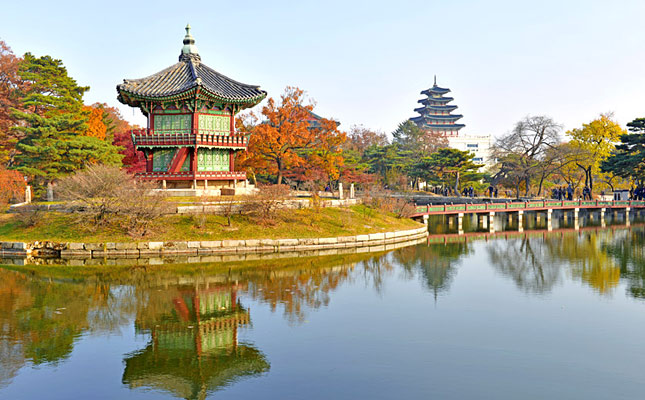[fshow photosetid=72157650065645297]
It is said that Seoul is the most wired city in the world – meaning more than 95 percent of the city’s households have a broadband internet connection.
Not only that, the South Koreans are some of the most eager users of smart phones in the world and gaming rooms are nestled into every little corner of the metropolis. But there’s much more to Seoul than mobile technology; the city’s lively art scene is complemented by a happening food scene that has grabbed the attention of chefs and diners from around the world. Being entertained is certainly not an issue, but spending your time wisely could easily be a challenge.
Follow this 48-hour guide to make the most of Seoul’s best attractions.
Day 1
Morning Fascinations
Stomaching pickled, spiced cabbage first thing in the morning may not seem like your idea of a good start to the day, but Korea’s signature dish – kimchi – is served at almost every meal, including breakfast. So if you’re looking for a traditional experience, there’s no way round the ubiquitous cabbage. People who get used to eating the stuff report strange cravings once they leave Korea and that could happen to you too.
Suitably pickled you should start your first day’s sightseeing at Korea’s most famous royal residence, Gyeongbokgung Palace. Gyeongbokgung means ‘the palace greatly blessed by heaven’ and it was built in 1395 after the Joseon Dynasty moved the capital from Gaeseong to Seoul. The palace grounds cover a huge walled site of over 40 hectares, and along with gates, pavilions and living quarters also house the National Palace Museum of Korea and the National Folk Museum.
Food for Thought
After exploring the palace you will have probably worked up an appetite so for lunch it’s a good idea to head to the Insadong neighbourhood. The neighbourhood used to be the home of royalty and aristocratic families and still offers lots of atmosphere and charm.
Sit down at one of the many restaurants serving everything from traditional Korean fare to more modern fusion grub and then head off again to explore streets filled with art galleries, ceramics stores and traditional handcraft shops.
When you start to feel weary, stop off at one of Insadong’s many tea shops for a traditional Korean tea ceremony. Much like the Japanese tea ceremony, the ritual can be traced several hundred years back when it was used in the royal courts and as an offering to gods. Today, the tea ceremony is a pleasant contrast to Seoul’s otherwise hectic pace.
Culinary Capital
Chefs and foodies around the world have been taking more than a passing interest in Korean food in recent years. Not only will you regularly find kimchi, or variations thereof, in restaurants around the world, you will also notice that chefs increasingly mention Seoul and Korean food as the next big thing.
One venue in Seoul that’s been pushing the boundaries of traditional Korean cooking is Jungsik, a so-called ‘new Korean cuisine’ restaurant in the city’s fashionable Gangnam quarter. The concept is modern techniques using local ingredients and it’s so successful that you’re advised to book your table well in advance.
You can finish off a fabulous day in style at T-Lound – a modern bar in Gangnam with contemporary designs as strong as the cocktails that cross the bar. It was designed by celebrated local architect Baekseon Kim and offers a snapshot of chic in one of the world’s quirkiest capitals.
Day 2
Breath of Fresh Air
Get up early and head out of the city to Bukhansan – the only national park in the Seoul Metropolitan area. The park offers a welcome respite from the city and with a choice of ridges and valleys to explore, there’s a challenge to suit every level of fitness.
Several marked trails lead past clear streams, historical sites, viewing points and temples. The visitor number is limited to 1000 per day, however, so make sure to book your trip well in advance.
Retail Reconnaissance
Once back in the city proper, you can head to Namdaemun, the oldest and largest traditional market in all of South Korea. There you can find pretty much anything you want, from clothing and accessories, homeware and electrical appliances to art and handicrafts. Many of the traders have their own factories and the market also serves as a major wholesale centre for the rest of the country.
Following the city buzz, next head down to Cheonggyecheon Stream which runs right through the heart of the capital. Until 2005, it was covered by an overpass, but as part of the government’s efforts to make the city more liveable, the stream has been opened up and today acts as a natural refuge, it’s banks teeming with activity, especially during summer, with plenty of opportunity to people watch.
Party Time
For a sophisticated night out, climb above it all at Rufxxx – a multi-activity space that is a restaurant, lounge, art space and roof top bar all in one, with one of the best views of Namsan Tower in the city.
Finish off a fun packed adventure by partying the night away, Korean style, at one of Gangnam’s many nightclubs, or head down to the more laid back area of Itaewon, which was once known for its red light district. Recently however, the area has been cleaned up and is home to some cool, friendly bars for a night cap.
Kick off the Virtual Tour
Like any capital city, Seoul offers visitors far too many options than they will have time to explore on a short trip. That’s why it’s best to narrow down your choices and explore the city online before you strike out in reality. Here are some links to kick off the virtual tour.
- Gyeongbokgung Palace: http://www.royalpalace.go.kr/html/eng/main/main.jsp
- Jungsik:http://jungsik.kr/seoul/#index
- T-Lound: http://www.74lound.com
- Bukhansan National Park: http://english.visitkorea.or.kr/enu/SI/SI_EN_3_1_1_1.jsp?cid=264309

